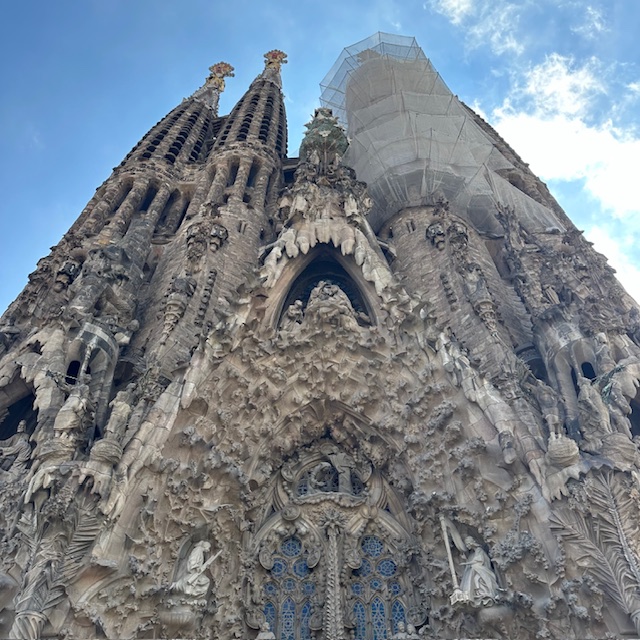Tourism is for Beginners
And we are all beginners

Hi friends. I am back from fifteen days traipsing around Europe, just like every other person on the planet, and I have some thoughts I’d like to share. As I mentioned last week, the impact of selfie culture on the tourist experience was far greater than it has been in the past. It really made unpleasant crowds even more unpleasant. It’s as though 40% of the crowd is staring deeply into their own pool of Narcissus, only postured so that Big Ben is in the background just right.
Sagrada Familia was one of the stops on our trip. Before I get into my observations about the experience, let me answer the question that is no doubt burning in your mind: No, we were not assaulted by water pistols by angry Barcelona protesters while we were there. It did occur to me that a water pistol would be just the thing for stopping Instagrammers though.
Anyway, back to Sagrada Familia. The place is both an active construction site and as mobbed as the days at Disneyland when a new Star Wars-themed ride is being opened. It’s like a bait ball of tourists. I anticipated that based on my other visits on this trip (London, Venice). At the same time, I think it would have been cultural malpractice to NOT see Sagrada Familia. It’s an incredible piece of work, both historically anachronistic and totally modern at the same time. A basilica in progress that is catholic in every sense of the word and also strangely non-denominational. Maybe even non-religious.
There are a lot of places on the planet like this: singular monuments both natural and man-made which must be seen if you are in their proximity. They vastly exceed their images. And while you are there, you will be immersed in suffocating crowds of people you detest. It’s part of the price of admission.
It’s also, I would argue, a ritual of initiation into a place. There are some places you must see before you are allowed to meet the other parts of that place. The quieter places, the more sublime parts of new world you are meeting, are reserved for those who’ve run the gauntlet of other initiates. And maybe you never go back to that place, in which case, you saw the big stuff and you expanded your world ever so slightly. But maybe you go back that place, and now you look for the quieter parts, and fall in love with them, and you stop looking like such a goddamn goof that the locals don’t want to shoot you with a water pistol.
Another observation about Sagrada Familia, and other tourist attractions that are semi-organized chaos: the unpleasantness of the experience is a design decision. I won’t run you through the tedium of the experience of being herded like goats through a crowd of other herds, but there were so many obvious ways that the whole affair could be better organized. A few rules (specifically, no cell phones), a few stanchions, a little signage - all of this would make the experience less anxiety-inducing. And since they rely on private fundraising to build this crazy place, a more streamlined, pleasant experience would give them a basis to hit people up for money at the end.

I don’t think there’s a big incentive for cities to streamline their tour experiences. Keeping all the tourists trapped in giant mazes where the walls of the maze are other tourists is a good way of keeping the tourists from going to the other, more pleasant, parts of the city. Tourist “traps” are zones where tourists can be managed and isolated from locals. The best way to get through these necessary monuments, this ritual of geographical initiation, is to treat it like a game you need to master. It is a trap, a maze, and your reward for making it out is that you can meet the rest of this beautiful place you are visiting.
One more tangential question: Why do we Anglicize proper names of places? I was thinking about this during a day trip to Padua, which the Italians call Padova. We call it Rome, they call it Roma. Venice, Venezia. Milan, Milano. Germany, Deutschland. Why don’t we call it what they call it?
That Top 100 List
Unless you are one of those people who has (rightfully) canceled their New York Times subscriptions because of their biased coverage of the presidential candidates, the war on Gaza, or trans rights, you are probably aware that they have recently compiled a list of the top 100 books of the 21st century. Here’s a gift link, if you’d like to look at it. It was compiled from the top ten lists of more than 500 writers and thinkers.
The Times also let readers choose their top ten. After several changes, here are mine:
- Ninth Street Women. Mary Gabriel
- The Year of Magical Thinking, Joan Didion
- Biography of X, Catherine Lacey
- The Underground Railroad, Colson Whitehead
- Far From the Tree, Andrew Solomon
- The Cost of Living, Deborah Levy
- The Great Escape, Saket Soni
- The Ministry for the Future, Kim Stanley Robinson
- The Friend, Sigrid Nunez
- Monsters: A Fan’s Dilemma, Claire Dederer
The ones I added and then removed: A Little Devil In America, Hanif Abdurraqib and Stolen Focus, Johann Hari. I picked all these because they are the books that have stayed with me long after I read them or have opened my eyes to a new way of thinking about something. It reflects a greater percentage of nonfiction than is typical of my reading diet, which I thought was interesting.
I’m interested to hear what’s on your list. Let me know in the comments!



